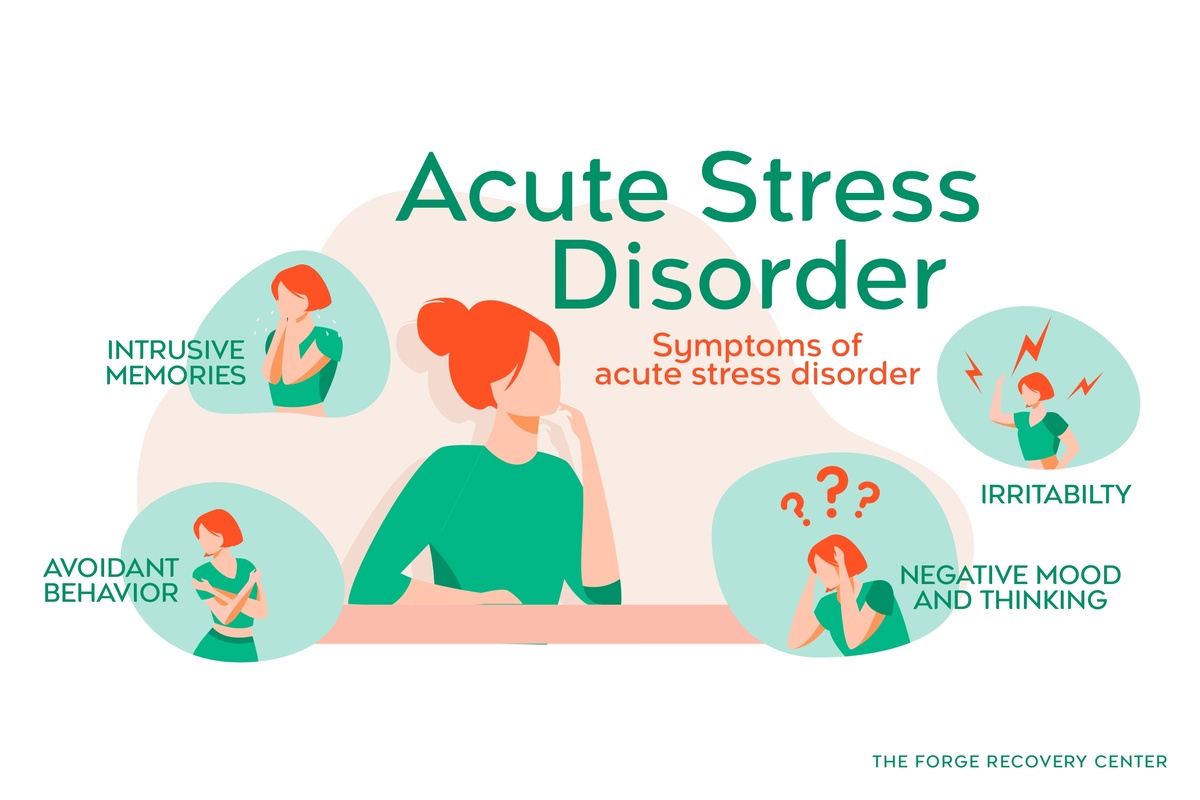Acute Stress Disorder: Symptoms and Treatment for This Trauma Disorder


Feeling overwhelmed by a recent traumatic event? Struggling to shake off persistent distressing thoughts and emotions? You might be experiencing acute stress disorder. This condition can leave you feeling on edge, replaying the event in your mind, and avoiding reminders of it. However, this trauma disorder is treatable.
What Is Acute Stress Disorder?
Acute stress disorder (ASD) is a mental health condition that can develop after experiencing or witnessing a traumatic event. It is similar to post-traumatic stress disorder (PTSD) and may even progress into PTSD if left untreated.
However, ASD occurs within one month of the trauma, while PTSD symptoms typically appear after one month.
Definition of Acute Stress Disorder
Acute stress disorder (ASD) is a temporary condition that develops after exposure to a traumatic event. It typically occurs within one month of the trauma. The key difference between ASD and PTSD lies in the timeframe for diagnosis; ASD symptoms last from three days to one month, while PTSD symptoms persist for more than a month. Rates of ASD are higher among survivors of accidents or natural disasters compared to those who have experienced violence.

What Are the Symptoms of Acute Stress Disorder?
The symptoms of acute stress disorder resemble those of post-traumatic stress disorder (PTSD). However, the symptoms of ASD are more short-lived and may last for a few days to one month.
Symptoms of acute stress disorder can be divided into emotional symptoms and physical symptoms.

Emotional Symptoms of Acute Stress Disorder
Individuals with ASD often face significant emotional challenges post-trauma. Emotional symptoms include anxiety, fear, guilt, and sadness. Recognizing and addressing these emotions are crucial in managing ASD effectively.
Symptoms of acute stress disorder have some crossover with the symptoms of PTSD:
Intrusive memories: Individuals with ASD may experience persistent and distressing thoughts, flashbacks, and nightmares about the traumatic event.
Avoidance behaviors: To cope with overwhelming emotions, individuals may avoid people, places, or activities that remind them of the trauma.
Negative changes in mood and thinking: This can manifest as feelings of hopelessness, difficulty remembering parts of the event, and changes in beliefs about oneself and the world.
Arousal symptoms: Individuals may feel on edge, irritable, or have trouble sleeping due to hypervigilance.
Physical Symptoms of Acute Stress Disorder
Physical symptoms such as headaches, stomachaches, rapid heartbeat, and muscle tension are common in individuals with Acute Stress Disorder. These physical manifestations can vary among individuals but are closely intertwined with the emotional distress experienced during ASD episodes.
They include:
Sleep disturbances: Individuals may have trouble falling or staying asleep due to recurring thoughts and nightmares.
Elevated heart rate: Individuals may experience a rapid or irregular heartbeat.
Tense muscles: This can manifest as headaches, stomachaches, or muscle pain.
Hypervigilance: Individuals may be extremely alert and easily startled.

Are You Struggling with Mental Health or Addiction?
We Can Help. Call Us Now!
CALL: 877-839-1772
Effective Treatments for Acute Stress Disorder
The most effective treatment for acute stress disorder is a combination of therapy and medication.
Therapy for Acute Stress Disorder: Psychological Interventions
Therapy plays a large role in treating acute stress disorder.
Cognitive Behavioral Therapy (CBT)
Cognitive behavioral therapy (CBT) plays a crucial role in treating Acute Stress Disorder by addressing negative thought patterns. CBT helps individuals recognize and challenge distorted beliefs, reducing anxiety symptoms.
Trauma-Focused Cognitive Behavioral Therapy (TF-CBT)
For those with ASD resulting from childhood trauma, trauma-focused cognitive behavioral therapy (TF-CBT) can be an effective treatment option. This type of therapy focuses on processing traumatic memories and developing coping skills to manage distress.
Eye Movement Desensitization and Reprocessing (EMDR) Therapy
Eye Movement Desensitization and Reprocessing (EMDR) therapy is another effective treatment for ASD. It involves recalling the traumatic event while making specific eye movements, which can help process the memories and decrease distress.
Early psychological interventions significantly contribute to preventing the development of PTSD after experiencing a traumatic event. By providing support and coping strategies promptly, individuals can better process their emotions and reduce the risk of long-term psychological effects.
Medication Options
Medication plays a vital role in managing symptoms of Acute Stress Disorder, especially when combined with therapy. Commonly prescribed medications for ASD include selective serotonin reuptake inhibitors (SSRIs) and benzodiazepines.
SSRIs
SSRIs work by increasing serotonin levels in the brain, which can help regulate mood and reduce anxiety levels. Benzodiazepines act as sedatives, promoting relaxation and reducing feelings of tension. It's important to note that medication should be part of a comprehensive treatment approach tailored to each individual's needs.
Treatment Centers for Acute Stress Disorder
For those struggling with acute stress disorder, there are treatment centers that specialize in trauma and related disorders. These facilities offer a safe and supportive environment for individuals to receive therapy and medication while also providing resources for long-term management.
What Is Treatment for Acute Stress Disorder Like?
Treatment for acute stress disorder varies from person to person. Some individuals may require more intensive treatment, while others may see improvement with lower levels of care.
Typically, treatment will begin with a thorough assessment by a mental health professional to determine the best course of action. This may include therapy sessions and/or medication management.
How Long Does Treatment Take?
The duration of treatment also varies depending on individual needs and progress. In some cases, acute stress disorder may resolve in a few months with proper treatment. It’s essential to consider factors such as development, diagnostic criteria, and evidence when tailoring treatment plans. Additionally, involving loved ones and providing patient education can enhance the overall efficacy of interventions.
For those experiencing traumatic events, such as natural disasters, physical assault, or witnessing bodily harm, early intervention is crucial. Immediate period support, care coordination, and access to emergency department services play a vital role in managing acute stress reactions.
Therapeutic Approaches
Therapeutic approaches like cognitive therapy, exposure therapy, and medications, including selective serotonin reuptake inhibitors, can help alleviate symptoms. Clinical trials and systematic reviews contribute to our understanding of effective treatment options.
Remember that each person’s experience is unique, and a comprehensive approach that considers individual risk factors, stress reactions, and sleep disturbance is essential. By providing practical support, mental health professionals can guide patients toward clinical improvement and better coping strategies.
Ultimately, addressing trauma exposure, understanding the impact of traumatic stress, and tailoring treatment to the general population are critical steps in managing acute stress disorder effectively.

Are You Struggling with Mental Health or Addiction?
We Can Help. Call Us Now!
CALL: 877-839-1772
What Causes Acute Stress Disorder?
Acute stress disorder is caused by experiencing or witnessing a traumatic event. This can include physical, emotional, or sexual abuse, natural disasters, accidents, or combat exposure.
Traumatic Events
Traumatic events triggering Acute Stress Disorder range from accidents and natural disasters to violent incidents like assault or abuse. The severity of the trauma plays a vital role in the development of ASD, with more intense experiences often leading to a higher likelihood of developing the disorder.
Certain trauma types are more likely to cause acute stress disorder. These include:
Interpersonal violence: This can include physical, emotional, or sexual abuse by a family member, partner, or acquaintance.
Natural disasters: Experiencing a natural disaster such as an earthquake, hurricane, or flood can be traumatic and trigger ASD.
Combat exposure: Military personnel are at a higher risk of developing ASD due to the intense and prolonged stress of combat.
Serious accidents: Being involved in or witnessing a severe accident can cause acute stress disorder.
Personal Experiences
Individuals who have experienced trauma during childhood or previous traumatic events are at a higher risk of developing acute stress disorder.
Pre-Existing Mental Health Conditions
Those with pre-existing mental health conditions, such as anxiety and depression, may also be more likely to develop ASD following a traumatic event. These conditions can make individuals more vulnerable to experiencing intense stress and difficulty coping after trauma. Additionally, individuals with a history of substance abuse or dependence may also be at an increased risk for developing ASD.
Risk Factors for ASD
Acute stress disorder and post-traumatic stress disorder (PTSD) are both trauma-related disorders that share many similarities. However, there are several key differences between the two.
Trauma Exposure
Experiencing traumatic events significantly increases the likelihood of developing Acute Stress Disorder (ASD). Individuals exposed to trauma may exhibit symptoms such as intrusive memories and flashbacks, which are hallmark signs of ASD. The intensity and frequency of trauma exposure play a crucial role in determining the risk of developing this disorder. For example, individuals who have experienced severe or repeated traumas are more vulnerable to developing ASD compared to those with limited exposure.
Cumulative trauma exposure refers to the accumulation of various traumatic events over time. This concept suggests that the combined impact of multiple traumas can heighten the risk of developing ASD. Each new traumatic event adds to the existing stress burden, making it harder for individuals to cope effectively. Therefore, understanding cumulative trauma exposure is essential in assessing and addressing the risk factors associated with ASD.
Personal History
An individual's personal history, including past traumatic experiences, can significantly influence the development of Acute Stress Disorder. Previous traumas can create a foundation that shapes how individuals respond to new traumatic events. For instance, someone with a history of childhood abuse may be more susceptible to experiencing ASD symptoms following a car accident or natural disaster.
Considering personal history is crucial in evaluating and treating individuals with ASD. Therapists and mental health professionals must explore past traumas to gain insights into the individual's emotional triggers and coping mechanisms. By understanding how past experiences contribute to current distress, clinicians can tailor interventions that address both the immediate symptoms of ASD and underlying psychological wounds.
Are You Struggling with Mental Health or Addiction?
We Can Help. Call Us Now!
CALL: 877-839-1772
Is Acute Stress Disorder Different From PTSD?
Acute stress disorder and post-traumatic stress disorder (PTSD) are both trauma-related disorders that share many similarities. However, there are several key differences between the two.
ASD Vs. PTSD
Acute Stress Disorder (ASD) and Post-Traumatic Stress Disorder (PTSD) are distinct yet interconnected conditions. ASD typically occurs within a month after a traumatic event, while PTSD symptoms may manifest later. In a few cases, ASD can progress to PTSD.
Symptoms like intrusive thoughts, avoidance behaviors, negative mood alterations, and hyperarousal characterize both disorders. However, the key difference lies in the duration of symptoms; for ASD, they persist for at least three days but not exceeding one month, whereas for PTSD, symptoms last longer than a month.
ASD and Adjustment Disorder
The relationship between Acute Stress Disorder (ASD) and Adjustment Disorder is complex. While both conditions involve emotional distress following a stressful event, their diagnostic criteria differ. Individuals with ASD experience severe anxiety or dissociation soon after the trauma, while Adjustment Disorder arises from difficulty coping with stressors in daily life.
It's possible for someone to have both disorders simultaneously due to overlapping symptoms like anxiety, depression, and impaired social functioning. Accurate diagnosis is crucial as it guides appropriate treatment strategies tailored to each condition's specific needs.

Predicting PTSD From ASD
While not everyone with ASD will go on to develop PTSD, research has shown that there are some factors that may increase the likelihood of transitioning from acute stress disorder to post-traumatic stress disorder.
Early Signs
Identifying the early signs of Acute Stress Disorder (ASD) is crucial for timely intervention. Symptoms such as intrusive memories, flashbacks, and avoidance behaviors may indicate the presence of ASD. Recognizing these signs early on can lead to effective management strategies.
Early detection plays a vital role in managing ASD. By identifying symptoms promptly, individuals can receive appropriate support and interventions to prevent the development of long-term consequences such as Post-Traumatic Stress Disorder (PTSD). Addressing ASD early can significantly reduce the risk of chronic psychological distress.
Recognizing and addressing early signs of ASD is essential in preventing long-term negative outcomes. By intervening early, individuals can learn coping mechanisms, access therapy, and develop resilience against potential PTSD development.
Assessment Tools
Common assessment tools like the Clinician-Administered PTSD Scale (CAPS) and the Acute Stress Disorder Interview (ASDI) are used to diagnose ASD accurately. These tools help clinicians evaluate the presence and severity of symptoms related to ASD, providing a comprehensive understanding of the individual's condition.
Assessment tools play a critical role in guiding treatment decisions for individuals with ASD. By assessing symptom severity and impact, clinicians can tailor interventions to address specific needs effectively. These tools also assist in monitoring progress throughout treatment and adjusting therapeutic approaches accordingly.
Incorporating assessment tools into clinical practice enhances diagnostic accuracy and ensures that individuals with ASD receive appropriate care. These tools serve as objective measures to assess symptomatology, track changes over time, and inform evidence-based treatment strategies.
Are You Struggling with Mental Health or Addiction?
We Can Help. Call Us Now!
CALL: 877-839-1772
The Impact of Acute Stress Disorder
Acute stress disorder can have a significant impact on an individual's daily life, relationships, and overall well-being. The symptoms of ASD can be debilitating and make it challenging to carry out daily tasks, maintain relationships, and engage in activities that were once enjoyable.
Short-Term Effects
Acute stress disorder (ASD) can trigger intense stress responses in individuals, leading to heightened anxiety and fear. These immediate stress reactions may manifest as intrusive memories, flashbacks, or nightmares. Such symptoms can significantly disrupt daily life activities and routines. Individuals may experience sleep disturbance due to persistent feelings of restlessness and agitation. The inability to concentrate or focus on tasks is common during this phase, impacting work or academic performance. Timely intervention through therapy or counseling is crucial to alleviate these short-term effects of ASD.
Long-Term Consequences
Untreated acute stress disorder can have severe long-term consequences on an individual's mental health and well-being. Persistent ASD symptoms left unaddressed may escalate into chronic impairment, affecting relationships, work productivity, and overall quality of life. Moreover, individuals with untreated ASD are at a higher risk of developing posttraumatic stress disorder (PTSD) in the future. Chronic exposure to stress reactions without intervention can lead to an increased vulnerability to PTSD development. Early intervention plays a pivotal role in preventing these long-term negative outcomes associated with acute stress disorder.
Prevention Strategies for Acute Stress Disorder
While it is not always possible to prevent acute stress disorder, there are some strategies that can help reduce the risk of developing this condition following a traumatic event.
Early Intervention
Early intervention plays a crucial role in managing Acute Stress Disorder. Seeking help promptly can significantly reduce the risk of developing PTSD. Healthcare providers are essential in offering timely support and interventions to individuals with ASD.
Prompt treatment after experiencing a traumatic event can prevent the escalation of symptoms into more chronic conditions like PTSD. By addressing the symptoms early on, individuals have a higher chance of recovering fully from ASD. Healthcare professionals play a key role in recognizing the signs of ASD and providing appropriate interventions.
Support Systems
Social support systems are vital for individuals dealing with Acute Stress Disorder. Family, friends, and community resources play a significant role in offering emotional support to those affected by ASD. Peer support groups and professional counseling can enhance coping mechanisms for individuals with ASD.
Having a strong support system can help individuals feel less isolated and overwhelmed by their symptoms. Family members and friends can provide comfort, understanding, and encouragement during difficult times. Community resources such as mental health organizations can offer additional assistance and access to specialized care when needed.

Recovery and Management
Recovery from acute stress disorder is possible with proper treatment and support. The duration of treatment may vary depending on individual needs and progress, but it typically involves therapy sessions and/or medication management.
Self-Care Techniques
Self-care is crucial for individuals with Acute Stress Disorder (ASD) to manage symptoms effectively. Engaging in mindfulness practices, such as deep breathing exercises, can help reduce anxiety levels. Developing relaxation techniques, like progressive muscle relaxation, aids in lowering stress responses.
Maintaining a healthy lifestyle through regular exercise, balanced nutrition, and sufficient sleep plays a significant role in managing ASD symptoms. These self-care strategies not only alleviate distress but also promote overall well-being. Implementing these practices consistently can lead to improved resilience and coping mechanisms.
Professional Support
For individuals struggling with Acute Stress Disorder, seeking professional support is essential. Mental health professionals, including psychologists and psychiatrists, offer specialized interventions tailored to address ASD symptoms effectively. Therapists trained in trauma-focused approaches provide counseling to help individuals process traumatic experiences and develop coping strategies.
The role of professional support extends beyond therapy sessions; it involves comprehensive assessment and personalized treatment plans. Collaborating with healthcare providers ensures effective care coordination for individuals experiencing ASD. Seeking timely professional help is crucial for long-term recovery and management of Acute Stress Disorder.
Closing Thoughts
You've delved into the depths of Acute Stress Disorder, understanding its nuances, risks, and impacts. Recognizing the connections to PTSD and the effectiveness of various treatments has equipped you with valuable knowledge to navigate these challenges. Remember, early intervention and tailored therapies play a crucial role in recovery and management.
As you move forward, consider implementing prevention strategies and seeking professional help if needed. Your proactive approach can make a significant difference in mitigating the effects of ASD. Stay informed, prioritize self-care, and remember that support is always within reach.
Acute Stress Disorder Treatment in Orange County
Acute stress disorder leaves you feeling alone and chained to events in your past. You desperately want the past to stay where it is...but the symptoms of ASD won't let you. However, surviving trauma means you're strong. All you need is a little help.
Guided by a trauma-informed approach, The Forge Recovery Center provides effective care for acute stress disorder. Our experienced therapists understand the complexities of trauma and can help you heal and reclaim your life.
Take the first step towards freedom from ASD and contact The Forge Recovery Center today. By seeking help, you are taking an important step towards healing and moving forward.



